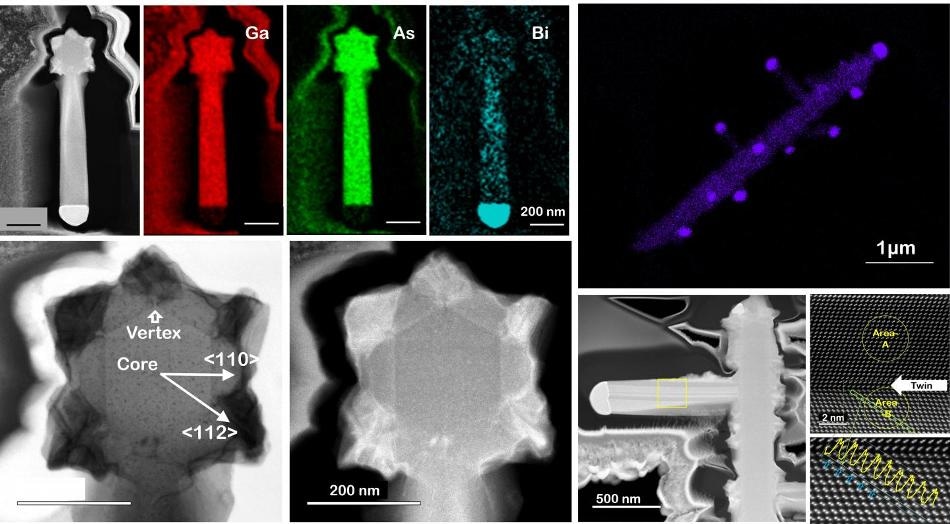Oct 22 2019
A nanowire can be defined as a rod-structure with a diameter usually narrower than several hundred nanometers. Owing to its structure and size, it displays characteristic properties that are not seen in bigger bulk materials.
 Microscopic observations of obtained nanowires. Characteristic hexagonal star structure, defect-defined quantum structures induced by the existence of Bi element were observed. (Image credit: Ehime University)
Microscopic observations of obtained nanowires. Characteristic hexagonal star structure, defect-defined quantum structures induced by the existence of Bi element were observed. (Image credit: Ehime University)
The exploration of III-V semiconductor nanowires has garnered a lot of interest in the last few decades because of their potential application in nanoscale quantum, electronic, photonic, and energy conversion, and in biological devices, based on their one-dimensional nature and large surface-to-volume ratio.
The addition of an epitaxial heterostructure enables control of the transport and electronic properties of such devices, demonstrating the potential for achieving integrated systems based on III-V compounds and Si with greater optical and electronic functions.
Currently available III-V compound semiconductors are one of the highest in photon-electron conversion efficiency and mobility. Among them, GaAs is demonstrative of III-V compound semiconductor, which is used in high-speed transistors, as well as high-efficiency near-infrared light-emitting diodes, solar cells, and lasers. Optical devices based on III-V GaAs experience intrinsic losses associated with heat generation.
To bypass this, the use of dilute bismide GaAsBi alloy with a nonhazardous Bi element has of late gained attention because the addition of Bi conquers heat generation while boosting electron-light conversion efficiency. Thus, adding dilute bismide GaAsBi alloy into nanowires is a rational technique for designing high-performance optoelectronic nanodevices.
For now, tree-like or branched nanowires provide an approach to boost structural complexity and improve the resulting operations, which, in turn, allow the realization of lateral connectivity, higher dimensionality structures, and interconnection between the nanowires.
Using an atomically precise crystal growth method known as molecular beam epitaxy, the Ehime University group regulated the formation of Bi-induced nanostructures in the growth of branched GaAs/GaAsBi core-shell nanowires. Thus, they facilitated a way to accomplish unexplored III-V semiconductor nanostructures using the characteristic supersaturation of catalyst droplets, structural alterations induced by strain, and integration into the host GaAs matrix correlated with crystalline flaws and orientations.
Their research results have been published in the September 17th issue of the Nano Letters.
The team had earlier acquired GaAs/GaAsBi heterostructure nanowires on Si with a 2% smaller Bi concentration than the preceding report. The nanowires displayed particular structural features, having an uneven surface with corrugations, which were perhaps induced by the large lattice disparity and ensuing strain accumulation between the GaAsBi and GaAs alloy.
Furthermore, Bi behaves as a surfactant in regulating the surface energy, thus inciting the synthesis of nanostructures. However, the influence of Bi integration on the GaAsBi alloy growth is far from being fully understood.
In the paper, they examine the features and growth mechanisms of GaAs/GaAsBi core-shell multi-layered NWs on Si (111) substrates, concentrating on the structural deformation induced by Bi. To synthesize branched III-V nanowires, traditionally, metallic catalyst nanoparticles, most generally Au, are used as the nucleation seeds for the development of the branches.
Conversely, the team used self-catalyst Ga and Bi droplets which can overpower the impurity introduction of non-constituent elements. When Ga is lacking during growth, Bi collects on the vertex of core GaAs nanowires and acts as a nanowire growth catalyst for the branched structures to particular crystalline azimuth. There is a robust connection between Bi accumulation and stacking faults.
Moreover, Bi is preferentially added on a restricted GaAs surface orientation, resulting in spatially selective Bi integration into a confined area that contains a Bi concentration 7% more than the fundamental limit. The acquired GaAs/GaAsBi/GaAs heterostructure with the interface established by the crystalline twin defects of one atomic layer, which can be possibly applied to a quantum-confined structure.
The finding offers a rational design concept for the creation of GaAsBi-based nanostructures and the control of Bi addition over the fundamental limit. These results specify the potential for a unique semiconductor nanostructure for efficient quantum electronics and near-infrared devices.